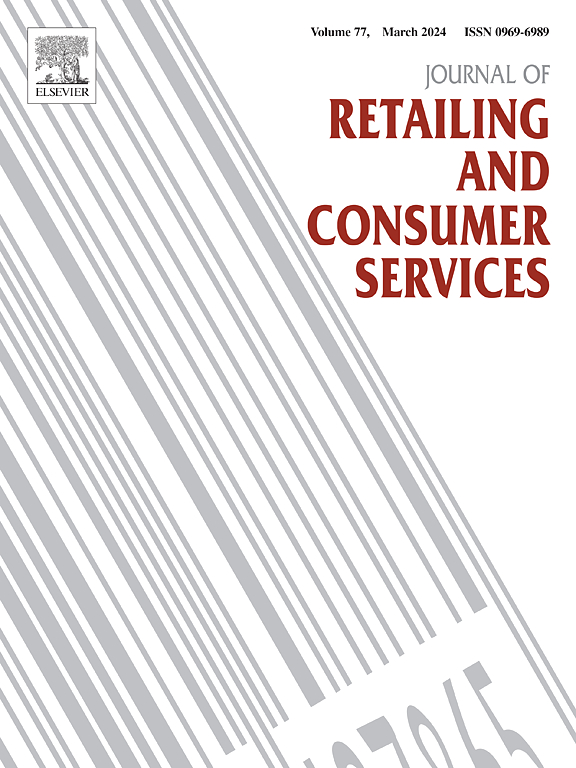监管焦点、处理不流畅性和购物目标对消费者对零售商移动广告中节省范围声明的看法的影响
IF 11
1区 管理学
Q1 BUSINESS
Journal of Retailing and Consumer Services
Pub Date : 2025-05-01
DOI:10.1016/j.jretconser.2025.104312
引用次数: 0
摘要
本研究调查了影响消费者对移动广告中节省范围声明看法的三个因素。由于此类声明本质上是模糊的,消费者感知不确定性,并通过锚定调整过程对折扣做出判断。我们预计消费者的监管焦点会对这些心理反应产生不同的影响。然而,当储蓄要求以不连贯的方式呈现时,这种效果将取决于消费者是否有购物目标。具体来说,有购物目标的消费者会进行更深思熟虑和系统的处理,从而改变他们最初的反应。相比之下,没有购物目标的消费者可能会依赖于自动和启发式处理,这加强了naïve关于不流畅理论的影响。为了验证这些假设,我们对372名韩国成年人进行了一项实验,采用了2 × 2 × 2的受试者间设计。结果显示,当购物目标存在时,以促销为中心的参与者认为折扣不太可信,对产品价值的判断更低,并且在省钱声明不流利时表现出更弱的购买意愿(对比流畅)。相反,在不流畅的条件下,以预防为重点的参与者对可信度、产品价值和购买意愿的感知更高。当没有购物目标时,参与者对不连贯的储蓄要求的反应更积极,而不管他们的监管重点是什么。这项研究扩展了我们对拉伸价格声明和监管焦点的理解,为处理流畅性的机制提供了新的见解,并为设计有效的定价策略和在线广告提供了指导方针,包括定制。本文章由计算机程序翻译,如有差异,请以英文原文为准。
The effects of regulatory focus, processing disfluency, and shopping goals on consumer perceptions of range-of-savings claims in retailers’ mobile ads
This research investigates three factors influencing consumer perceptions of range-of-savings claims in mobile ads. Since such claims are inherently ambiguous, consumers perceive uncertainty and make judgments about the discount through an anchor-adjustment process. We expect that consumers' regulatory focus will differentially affect these psychological responses. However, when savings claims are presented in a disfluent manner, this effect will vary depending on whether the consumer has a shopping goal. Specifically, consumers with a shopping goal engage in more deliberate and systematic processing, leading them to modify their initial responses. In contrast, consumers without a shopping goal are likely to rely on automatic and heuristic processing, reinforcing the influence of naïve theories about disfluency. To test the hypotheses, we conducted an experiment with three hundred seventy-two South Korean adults using a 2 x 2 x 2 between-subjects design. The results showed that when a shopping goal was present, promotion-focused participants perceived the discount as less credible, judged the product's value lower, and showed weaker purchase intentions when the savings claim was disfluent (vs. fluent). In contrast, prevention-focused participants' perceptions of credibility, product value, and purchase intentions were higher in the disfluent conditions. When no shopping goal was present, participants responded more positively to disfluent savings claims, regardless of their regulatory focus. This study extends our understanding of tensile price claims and regulatory focus, provides new insights into the mechanisms of processing fluency, and offers guidelines for designing effective pricing strategies and online ads, including customization.
求助全文
通过发布文献求助,成功后即可免费获取论文全文。
去求助
来源期刊
CiteScore
20.40
自引率
14.40%
发文量
340
审稿时长
20 days
期刊介绍:
The Journal of Retailing and Consumer Services is a prominent publication that serves as a platform for international and interdisciplinary research and discussions in the constantly evolving fields of retailing and services studies. With a specific emphasis on consumer behavior and policy and managerial decisions, the journal aims to foster contributions from academics encompassing diverse disciplines. The primary areas covered by the journal are:
Retailing and the sale of goods
The provision of consumer services, including transportation, tourism, and leisure.

 求助内容:
求助内容: 应助结果提醒方式:
应助结果提醒方式:


